Whether you’re using the oven, slow cooker, or smoker, I’ve got you covered with some tried-and-true tips to ensure your pulled pork is nothing short of spectacular. If you’re like me, you appreciate the art of making mouthwatering meals right in your own kitchen. Today, I want to share my decades-worth of experience on a classic favorite: Pulled Pork.
Unlocking the secret to succulent pulled pork has never been easier! This versatile recipe allows you to effortlessly whip up this culinary masterpiece using your oven, slow cooker, or Instant Pot.
The star of the show is the Boston butt pork shoulder, harmoniously blended with a medley of flavorful spices. The addition of apple cider vinegar works its magic, tenderizing the meat to perfection, while a hint of brown sugar adds just the right touch of sweetness and balance.
The result? A symphony of tender, juicy, and downright delicious pork that’s destined to be a crowd-pleaser. Get ready to savor the simplicity of this recipe as it transforms your kitchen into a haven of irresistible aromas and unparalleled taste.
Great for a weeknight dinner at home or perfect for feeding a crowd that never disappoints.
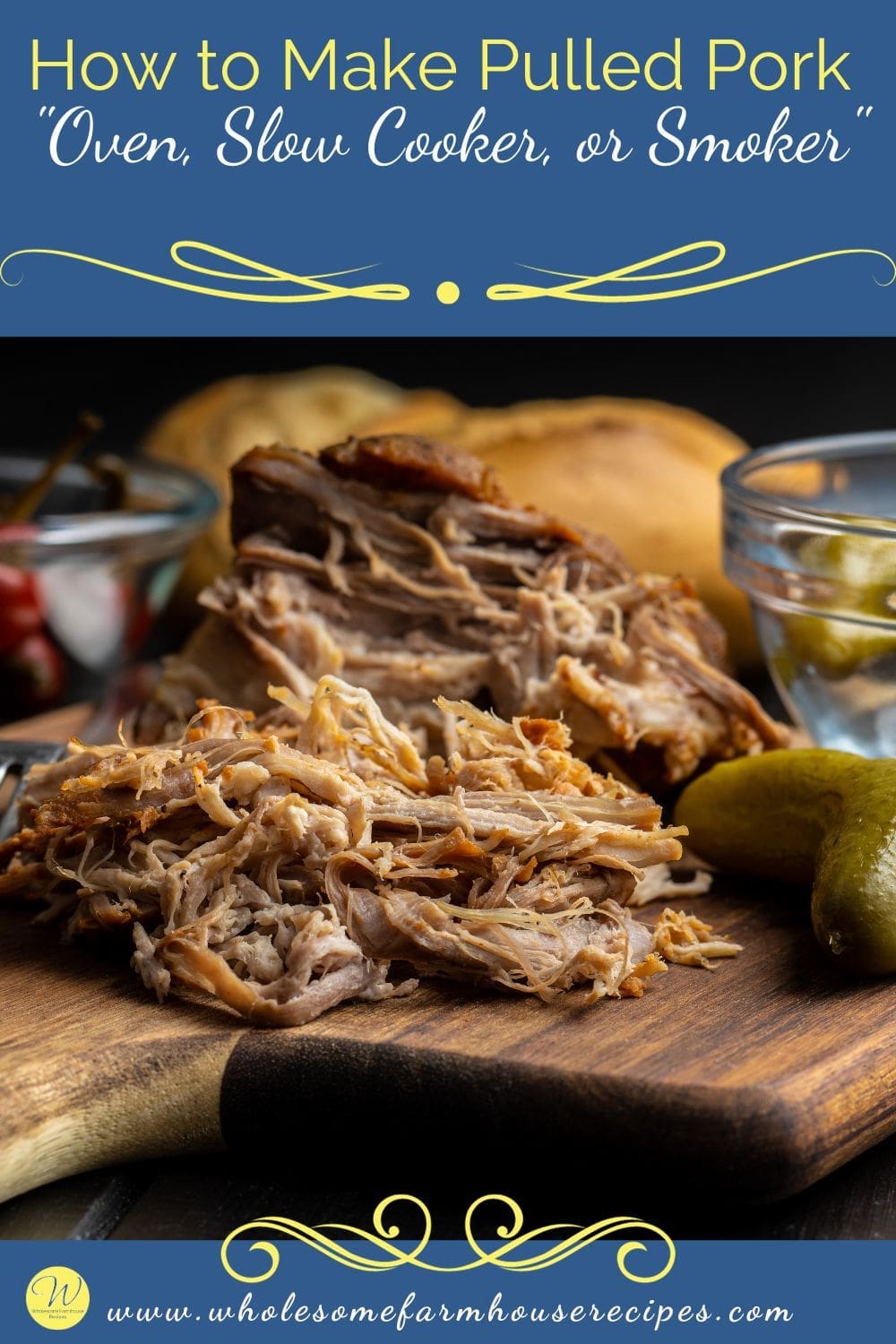
Table of contents
- Best pulled pork recipe
- What’s the best cut of meat for pulled pork?
- Will a bone-in pork shoulder work with this recipe?
- Can you make pulled pork with pork loin?
- Elevate Your Pulled Pork with Our Flavorful Seasoning Blend
- What’s the best method for cooking pulled pork?
- How long does it take to cook pulled pork in oven per pound?
Best pulled pork recipe
Today, we are sharing our best pulled pork recipe made three different ways, Oven, Slow Cooker, or Smoker.
What’s the best cut of meat for pulled pork?
If you’re specifically looking for the best cut for pulled pork, pork shoulder is the go-to choice for many. It’s relatively inexpensive compared to other cuts, and its fat content contributes to the juicy and succulent texture that is characteristic of well-prepared pulled pork.
Pulled pork is typically made from pork shoulder, also known as pork butt or Boston butt. Despite the name, it comes from the upper part of the front shoulder of the pig. This cut is well-marbled with fat and has connective tissues that break down during slow cooking, resulting in tender, flavorful pulled pork.
For this recipe, opt for a 3-5 pound boneless pork shoulder.
Will a bone-in pork shoulder work with this recipe?
Absolutely! While it might require a tad more time in the cooking process, a bone-in cut can still be a stellar option. Just be sure to check the internal temperature towards the end of the cooking duration to gauge its doneness.
Can you make pulled pork with pork loin?
While some might attempt it with tenderloin or pork chops, we strongly advise against it. These cuts tend to resist shredding properly and may yield a dry, solid chunk of meat. Stick to the readily available pork shoulder, found in most markets, for the optimal pulled pork experience. Happy cooking!
Elevate Your Pulled Pork with Our Flavorful Seasoning Blend
This seasoning blend offers a balance of sweet, smoky, and savory flavors with a hint of heat. When it comes to pulled pork, the seasoning is the key to transforming it from bland to extraordinary. Our meticulously crafted seasoning blend comprises pantry essentials, each contributing in perfect harmony to achieve unparalleled flavor. Featuring a medley of simple ingredients using brown sugar, garlic powder, onion powder, cumin, smoked paprika, ground mustard, salt, pepper, and a touch of cayenne, this blend is designed to tantalize your taste buds.
To achieve optimal results, resist the temptation to omit any ingredient. Instead, generously rub this flavorful blend over every inch of the pork, ensuring it reaches into every crack and crevice. Elevate your pulled pork game with this carefully curated seasoning, promising a symphony of savory, sweet, and subtly spicy notes in every bite.
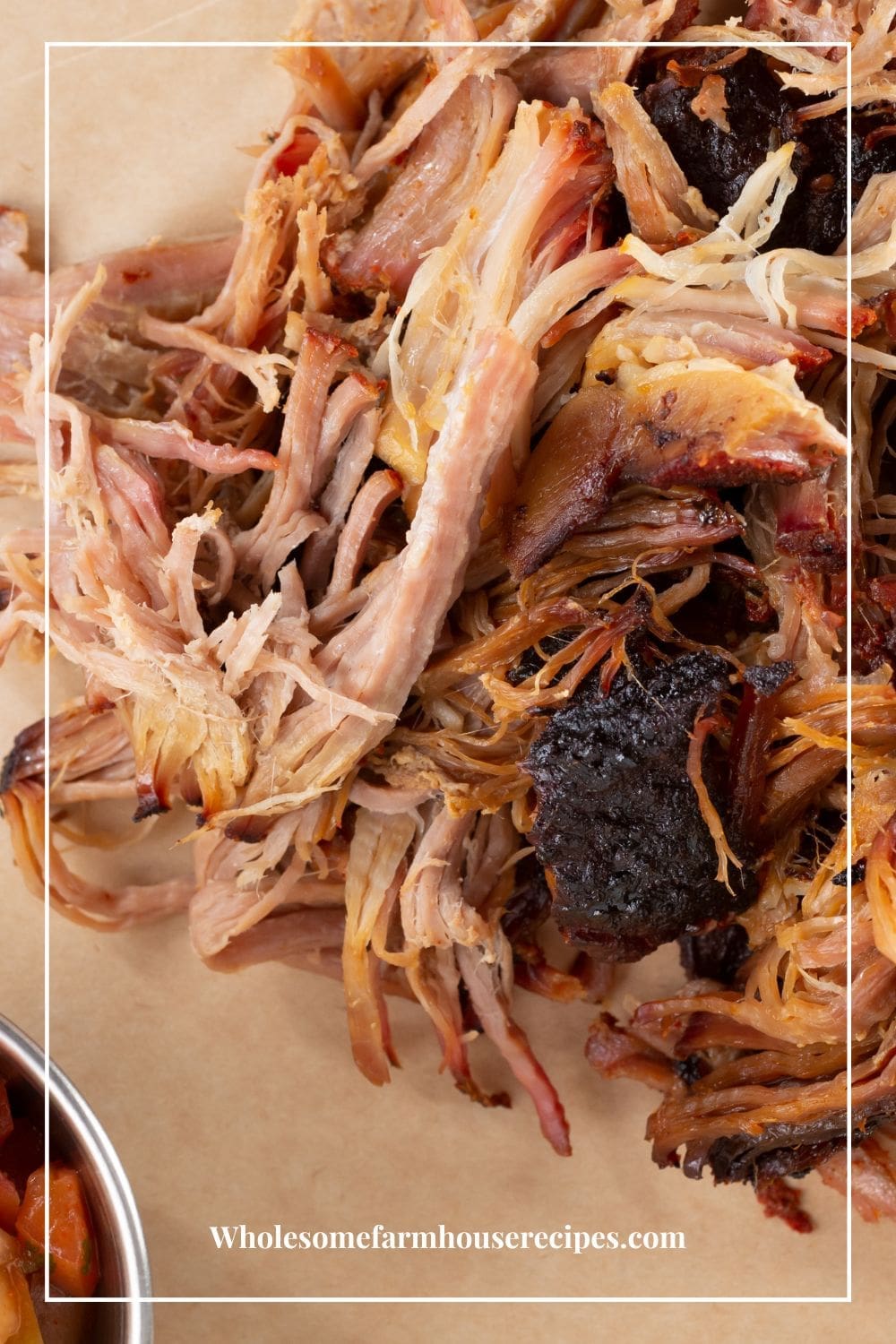
What’s the best method for cooking pulled pork?
The best method for cooking pulled pork is low and slow. This allows the collagen in the meat to break down slowly, resulting in tender and flavorful pulled pork. There are several ways to cook pulled pork, but the most popular methods are smoking, slow cooking, and oven roasting. Here are some of the best methods for cooking pulled pork:
Smoking Pork Shoulder
Smoking is a traditional method of cooking pulled pork that involves cooking the meat over low heat for several hours. This method imparts a smoky flavor to the meat and makes it tender and juicy.
Soak wood chips in water for about 30 minutes before using. Try different wood chip varieties (hickory, apple, cherry) to impart unique smoky flavors to the pork.
Place them in the smoker box or directly on the hot coals to generate smoke. This adds the signature smoky flavor to your pork.
Put the seasoned pork shoulder on the smoker rack with the fat side up. This allows the fat to baste the meat as it cooks.
Keep an eye on the smoker temperature, adjusting vents or adding charcoal as needed. Aim for a steady temperature throughout the cooking process.
Optionally, you can spritz the pork with apple juice or water every hour or so to keep it moist. This step adds another layer of flavor and helps form a delicious bark on the outside.
Plan for 1.5 to 2 hours of cooking time per pound of pork. The pork is ready when it reaches an internal temperature of 195-205°F (91-96°C).
Slow Cooking Pork Shoulder
This method involves cooking the meat in a slow cooker or crockpot for several hours until it is tender and falls apart easily.
An easy method to set it and forget it as low and slow is still the name of the game. Put the seasoned pork shoulder in the slow cooker. If searing, deglaze the pan with a bit of broth and pour the flavorful liquid into the slow cooker.
Add a bit of liquid, set it on low, and let time do its thing. In 8-10 hours, you’ll have tender pulled pork without breaking a sweat.
Around the 8-hour mark, check the internal temperature of the pork. It should be in the range of 195-205°F (91-96°C). The pork should be very tender and easily pulled apart with a fork.
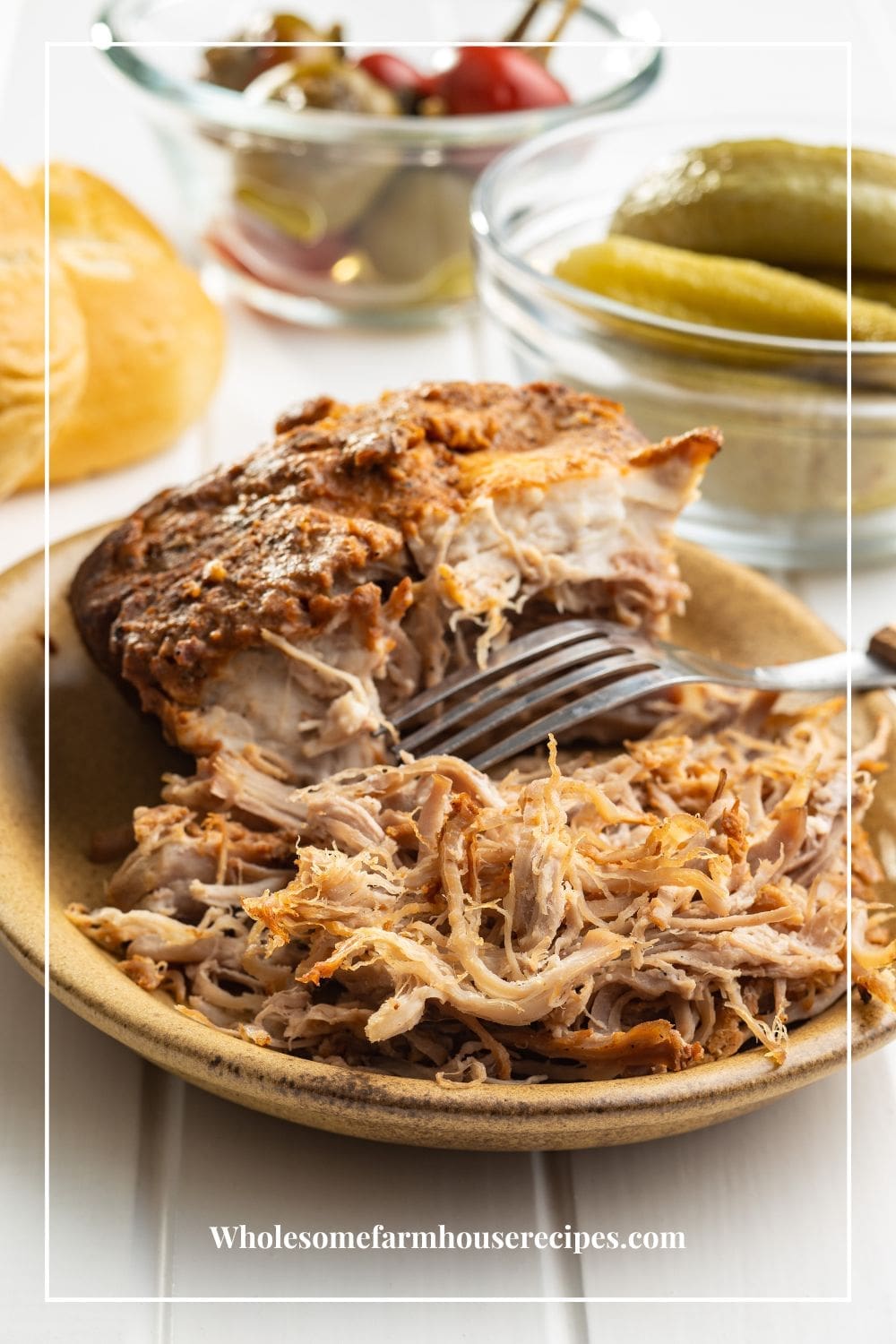
Oven Roasting Pork Shoulder
Oven roasting is a simple and easy method of cooking pulled pork. This method involves cooking the meat in the oven at a low temperature for several hours until it is tender and falls apart easily.
Preheat your oven to 225-250°F (107-121°C). Place the seasoned pork in a roasting pan, cover it, and let it work its magic.
Put the seasoned pork shoulder in a roasting pan, Dutch oven, or on a rack inside a baking dish, fat side up. This allows the fat to baste the meat as it cooks.
Pour 1 cup of chicken broth or water into the bottom of the roasting pan. This helps keep the pork moist during the cooking process.
Cover the pork with aluminum foil or a tight-fitting lid. Roast in the preheated oven for several hours, allowing 1.5 to 2 hours per pound of pork.
Around the 6-hour mark, start checking the internal temperature. The pork is ready when it reaches 195-205°F (91-96°C).
Professional tips when making pulled pork
Regardless of the method you choose, here are some tips to keep in mind:
Inject for Moisture. Use a meat injector to add a flavorful liquid (broth, apple juice, or marinade) directly into the pork. This can enhance moisture and flavor throughout the meat.
Use a boneless pork shoulder for the best results.
Trim off any excess fat from the pork shoulder.
Season the pork shoulder with a dry rub or marinade to add flavor.
Chill the meat after adding the spice rub. Dry Brine for Flavor. Consider dry brining the pork by applying the spice rub a day before cooking. Allowing the pork to rest in the refrigerator after applying the spice rub gives the seasonings more time to permeate the meat, resulting in a more flavorful end product. This is particularly true for dry rubs, where the spices can meld and penetrate the surface of the meat.
Cook the pork shoulder slowly over low heat to allow the protein to break down properly.
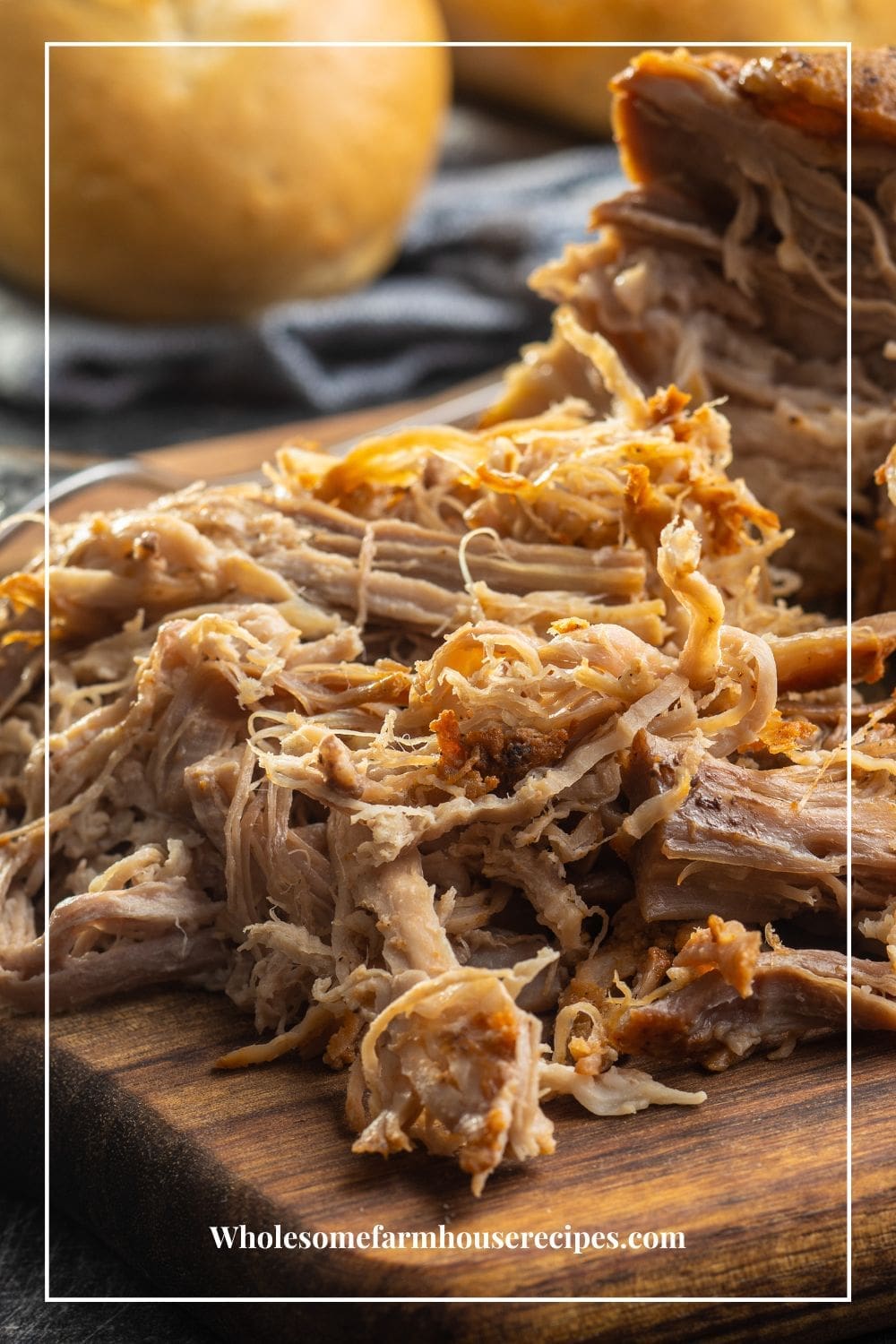
Pull the pork apart by hand to retain moisture. Use two forks or meat claws to shred the pork into bite-sized pieces, discarding any large pieces of fat.
Searing can enhance the overall flavor and appearance of the pulled pork. The Maillard reaction that occurs during searing contributes to a complex flavor profile, adding depth to the final dish. However, if you’re short on time or prefer a simpler preparation, you can skip the searing step, and your pulled pork will still turn out delicious.
Use a Meat Thermometer. Invest in a meat thermometer to monitor the internal temperature. Pull the pork when it reaches 195-205°F (91-96°C) for optimal tenderness.
Let the cooked pork rest for at least 30 minutes before pulling. This allows the juices to redistribute, keeping the meat moist.
How long does it take to cook pulled pork in oven per pound?
As a general guideline, you can estimate a cooking time of about 1.5 to 2 hours per pound at a low and slow temperature of around 225-250°F (107-121°C).
The cooking time for pulled pork in the oven can vary based on factors such as the size of the pork shoulder, the oven temperature, and the desired level of doneness.
Here’s a basic calculation:
Estimate the Weight of the Pork Shoulder: Let’s say you have a 6-pound pork shoulder.
Calculate Cooking Time: Multiply the weight by the estimated cooking time per pound. For example, 6 pounds x 1.5 hours = 9 hours or 6 pounds x 2 hours = 12 hours.
Keep in mind that these are rough estimates, and the actual cooking time may vary. It’s important to use a meat thermometer to check the internal temperature of the pork. The pork is generally ready for pulling when it reaches an internal temperature between 195-205°F (91-96°C).
Additionally, it’s a good idea to allow some extra time for resting the meat after it’s cooked, usually around 30 minutes to let the juices redistribute. Always monitor the internal temperature and adjust the cooking time as needed to achieve the desired tenderness.
How to Make Pulled Pork “Oven, Slow Cooker, or Smoker”
As an Amazon Associate I earn from qualifying purchases.
Kitchen Essentials
Ingredients
- 3-4 Pound Boneless Pork Shoulder Boston Butt
- 1/2 Cup Chicken Broth
- 1/3 Cup Apple Cider Vinegar
- 1/4 Cup Brown Sugar Packed in the cup for measuring
- 3 Teaspoons Kosher Salt
- 2 Teaspoons Garlic Powder
- 2 Teaspoons Onion Powder
- 2 Teaspoons Smoked Paprika
- 2 Teaspoons Dry Mustard
- 1 Teaspoon Cumin
- 1 Teaspoon Black Pepper
- 1/4 Teaspoon Cayenne Pepper or to taste
Instructions
- Trim the excess fat, but not all of it, from the pork shoulder. Cut into large equal size pieces for even cooking.3-4 Pound Boneless Pork Shoulder
- In a small bowl whisk together the spice rub mixture; brown sugar, salt, garlic powder, onion powder, smoked paprika, dry ground mustard, cumin, black pepper, and cayenne pepper. Rub the spice mixture all over the pork pieces, getting in the nooks and crannies.1/2 Cup Chicken Broth, 1/3 Cup Apple Cider Vinegar, 1/4 Cup Brown Sugar, 3 Teaspoons Kosher Salt, 2 Teaspoons Garlic Powder, 2 Teaspoons Onion Powder, 2 Teaspoons Smoked Paprika, 2 Teaspoons Dry Mustard, 1 Teaspoon Cumin, 1 Teaspoon Black Pepper, 1/4 Teaspoon Cayenne Pepper
- If you have the time, chill the meat. Place the seasoned pork in the refrigerator, either uncovered or covered with plastic wrap, for several hours or overnight. This extended time allows the flavors to develop and the spices to infuse into the meat.
- Before cooking, let the pork come to room temperature for about 30 minutes for even cooking.
Smoking Pork Shoulder
- Smoking is a traditional method of cooking pulled pork that involves cooking the meat over low heat for several hours. This method imparts a smoky flavor to the meat and makes it tender and juicy.
- Soak wood chips in water for about 30 minutes before using. Try different wood chip varieties (hickory, apple, cherry) to impart unique smoky flavors to the pork.
- Place them in the smoker box or directly on the hot coals to generate smoke. This adds the signature smoky flavor to your pork.
- Put the seasoned pork shoulder on the smoker rack with the fat side up. This allows the fat to baste the meat as it cooks.
- Keep an eye on the smoker temperature, adjusting vents or adding charcoal as needed. Aim for a steady temperature throughout the cooking process.
- Optionally, you can spritz the pork with apple juice or water every hour or so to keep it moist. This step adds another layer of flavor and helps form a delicious bark on the outside.
- Plan for 1.5 to 2 hours of cooking time per pound of pork. The pork is ready when it reaches an internal temperature of 195-205°F (91-96°C).
Slow Cooking Pork Shoulder
- This method involves cooking the meat in a slow cooker or crockpot for several hours until it is tender and falls apart easily.
- An easy method to set it and forget it as low and slow is still the name of the game. Put the seasoned pork shoulder in the slow cooker. If searing, deglaze the pan with a bit of broth and pour the flavorful liquid into the slow cooker.
- Add a bit of liquid, set it on low, and let time do its thing. In 8-10 hours, you’ll have tender pulled pork without breaking a sweat.
- Around the 8-hour mark, check the internal temperature of the pork. It should be in the range of 195-205°F (91-96°C). The pork should be very tender and easily pulled apart with a fork.
Oven Roasting Pork Shoulder
- Oven roasting is a simple and easy method of cooking pulled pork. This method involves cooking the meat in the oven at a low temperature for several hours until it is tender and falls apart easily.
- Preheat your oven to 225-250°F (107-121°C). Place the seasoned pork in a roasting pan, cover it, and let it work its magic.
- Put the seasoned pork shoulder in a roasting pan, Dutch oven, or on a rack inside a baking dish, fat side up. This allows the fat to baste the meat as it cooks.
- Pour 1 cup of chicken broth or water into the bottom of the roasting pan. This helps keep the pork moist during the cooking process.
- Cover the pork with aluminum foil or a tight-fitting lid. Roast in the preheated oven for several hours, allowing 1.5 to 2 hours per pound of pork.
- Around the 6-hour mark, start checking the internal temperature. The pork is ready when it reaches 195-205°F (91-96°C).
- Let the cooked pork rest for at least 30 minutes before pulling. This allows the juices to redistribute, keeping the meat moist.
- Pull the pork apart by hand to retain moisture. Use two forks or meat claws to shred the pork into bite-sized pieces, discarding any large pieces of fat.
Your Own Private Notes
Notes
Professional tips when making pulled pork
Regardless of the method you choose, here are some tips to keep in mind: Choose the Right Cut. Opt for a well-marbled cut like pork shoulder or Boston butt. The higher fat content contributes to moisture and flavor during the slow-cooking process. Dry Brine for Flavor. Consider dry brining the pork by applying the spice rub a day before cooking. This allows the salt and spices to penetrate the meat, enhancing the flavor. Inject for Moisture. Use a meat injector to add a flavorful liquid (broth, apple juice, or marinade) directly into the pork. This can enhance moisture and flavor throughout the meat. Use a boneless pork shoulder for the best results. Trim off any excess fat from the pork shoulder. Season the pork shoulder with a dry rub or marinade to add flavor. Chill the meat after adding the spice rub. Allowing the pork to rest in the refrigerator after applying the spice rub gives the seasonings more time to permeate the meat, resulting in a more flavorful end product. This is particularly true for dry rubs, where the spices can meld and penetrate the surface of the meat. Cook the pork shoulder slowly over low heat to allow the protein to break down properly. Pull the pork apart by hand to retain moisture. Use two forks or meat claws to shred the pork into bite-sized pieces, discarding any large pieces of fat. Searing can enhance the overall flavor and appearance of the pulled pork. Searing can enhance the overall flavor and appearance of the pulled pork. The Maillard reaction that occurs during searing contributes to a complex flavor profile, adding depth to the final dish. However, if you’re short on time or prefer a simpler preparation, you can skip the searing step, and your pulled pork will still turn out delicious. Use a Meat Thermometer. Invest in a meat thermometer to monitor the internal temperature. Pull the pork when it reaches 195-205°F (91-96°C) for optimal tenderness. Let the cooked pork rest for at least 30 minutes before pulling. This allows the juices to redistribute, keeping the meat moist.Nutrition
Can you freeze pulled pork?
Yes, you can freeze pulled pork. Freezing is a convenient way to store leftover pulled pork for an extended period. Here’s how.
Use an Airtight Container or Freezer Bag. Squeeze out as much air as possible before sealing to reduce the risk of freezer burn. Divide the pulled pork into smaller portions that you’re likely to use in one go. This makes it easier to thaw only what you need.
Clearly label the containers or bags with the date of freezing. This helps you keep track of how long the pulled pork has been in the freezer.
Best way to reheat pulled pork?
Reheating pulled pork properly is important to maintain its flavor and tenderness. Here are a few methods you can use:
Oven:
Preheat your oven to around 225°F (107°C).
Place the pulled pork in an oven-safe dish and cover it with foil to prevent drying.
Heat for about 20-30 minutes or until it reaches your desired temperature.
Slow Cooker:
Place the pulled pork in the slow cooker.
Add a bit of liquid (broth, apple juice, or barbecue sauce) to prevent it from drying out.
Heat on the low setting for 1-2 hours, stirring occasionally.
Stovetop:
Reheat in a saucepan over low to medium heat.
Add a little liquid to keep it moist and prevent sticking.
Microwave:
This is the quickest method, but it can result in uneven heating.
Place a damp paper towel over the pulled pork to help retain moisture.
Use short intervals, stirring between each, to ensure even heating.
Tips:
Add Moisture: Whether using the oven, slow cooker, or stovetop, consider adding a bit of liquid to the pulled pork. This can be barbecue sauce, broth, apple juice, or a combination. It helps keep the meat moist during reheating.
Avoid Overheating: Pulled pork can dry out if overheated. Keep a close eye on it, and take it out as soon as it reaches your desired temperature.
Stir and Break Apart: Stir the pulled pork occasionally during reheating to distribute heat evenly. This also helps break apart any clumps.
Check Temperature: If using a meat thermometer, ensure the pulled pork reaches a safe temperature of at least 165°F (74°C).
By following these methods and tips, you can effectively reheat pulled pork while maintaining its delicious flavor and texture.
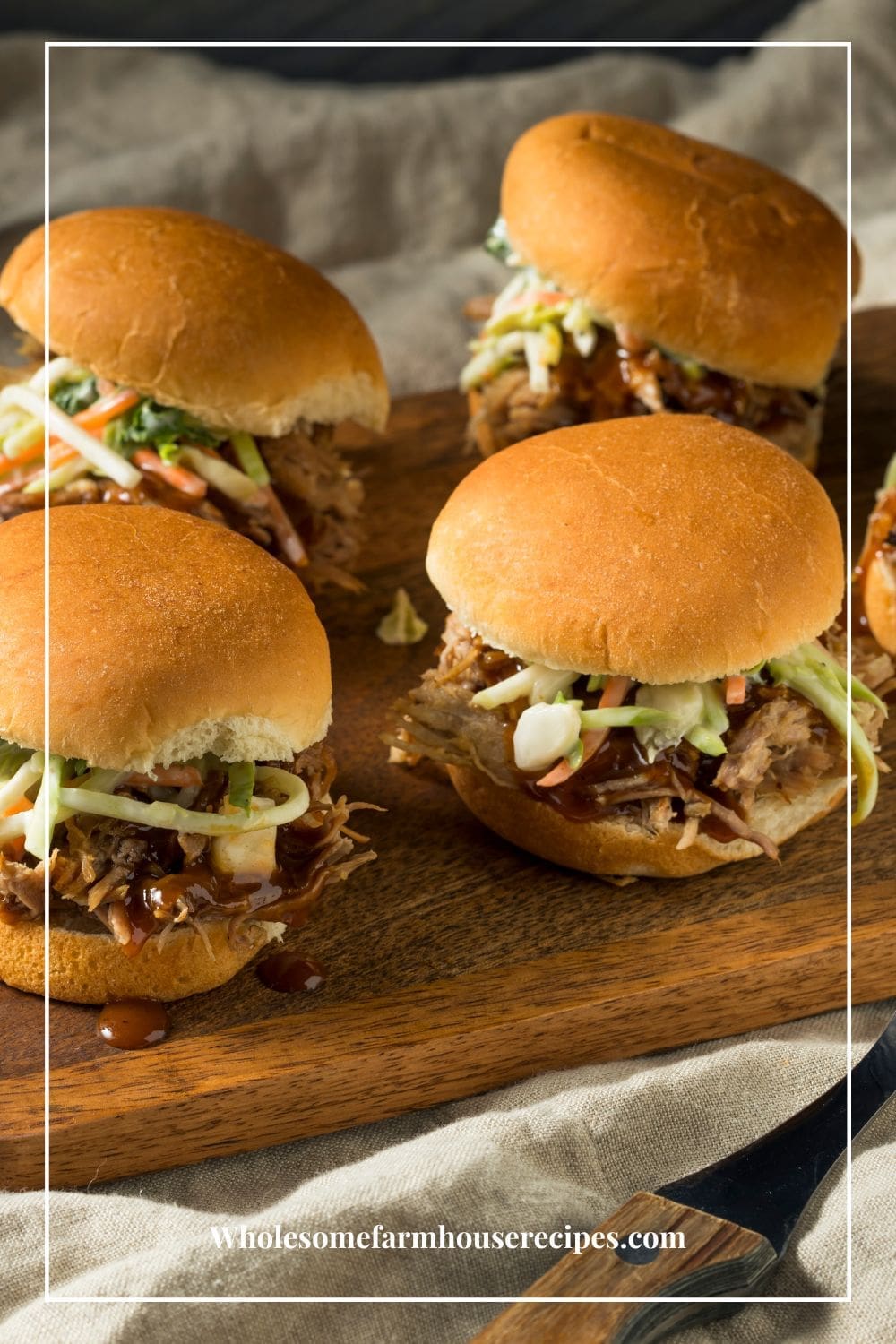
How many sandwiches per pound of pulled pork?
As a rough estimate, you might get about 3 to 4 sandwiches per pound of pulled pork if you’re using a standard serving size.
Here are some things to consider:
Sandwich Size: The size of your sandwiches will have a significant impact on how many you can make per pound. If you’re making smaller sliders, you’ll get more sandwiches than if you’re making larger, more substantial sandwiches.
Depending on how much pulled pork you want to put in each sandwich, it will affect the servings you will get out of each pound. Some people prefer a generously filled sandwich, while others may prefer a lighter serving.
Consider any additional accompaniments you plan to add to the sandwiches, such as coleslaw, pickles, or extra sauce. These can affect the overall quantity of sandwiches.
If you’re serving a crowd, it’s always a good idea to make a bit more than you think you’ll need to ensure everyone has enough to enjoy.
Find out even more about how much meat to plan per person for pulled pork, plus another recipe for making pulled pork.
Prepare for Leftovers
Pulled pork leftovers are versatile. Plan to use them in pork sandwiches, tacos, wraps, or salads for quick and delicious meals throughout the week.
What to serve with Pulled Pork Sandwiches?
Feel free to mix and match these side dishes based on your preferences and the occasion.
- The crisp and refreshing nature of coleslaw complements the richness of pulled pork. Consider classic coleslaw with a creamy dressing or a vinegar-based slaw for a tangy contrast.
- Dill pickles or bread-and-butter pickles add a crunchy, tangy element that cuts through the richness of the pulled pork.
- Sweet and smoky baked beans are a classic barbecue side that pairs wonderfully with pulled pork. They add a hearty and flavorful element to the meal.
- Creamy mac and cheese provides a comforting and cheesy side dish that contrasts well with the savory pulled pork.
- Sweet or savory cornbread is a perfect accompaniment. The combination of the tender pork and the crumbly texture of cornbread is a match made in heaven.
- Whether it’s a classic mayo-based potato salad or a tangy vinegar-based version, potato salad adds a satisfying element to your pulled pork feast.
- Grilled vegetables, such as zucchini, bell peppers, or asparagus, bring a charred and smoky flavor that complements the pulled pork.
- Crispy fried okra is a Southern favorite that adds a crunchy texture to the meal. The mild flavor works well with the bold taste of pulled pork.
- Slow-cooked collard greens with bacon or ham provide a hearty and flavorful side that balances the richness of the pulled pork.
- Sweet potato fries add a sweet and savory element that pairs well with the smokiness of the pulled pork.
- Grilled or boiled corn on the cob is a classic summer side that complements the barbecue flavors of pulled pork.
- Roasted Brussels sprouts with bacon or a balsamic glaze offer a flavorful and slightly crispy side dish.
The combination of textures and flavors will create a well-rounded and satisfying meal.
Other Pork Recipes and Cooking Tips
Here are a few more delicious recipes and cooking tips for you to explore.
- Learn How to Cook Smoked Pork Chops
- How To Grill The Best Juicy Grilled Pork Chops
- How to Season Pork Steak Best Homemade Recipe
- How to Cook Thin Pork Chops Without Drying Them Out
- How to Bake Frozen Pork Tenderloin Easy Recipe
- How Long to Cook Perfect Pork Tenderloin Per Pound
- Baked Smothered Pork Chops Recipe








